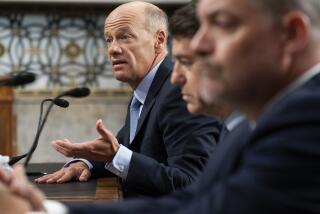Banks Post Record Profits but Regulator Issues Caveat
- Share via
WASHINGTON — U.S. banks earned a record $25.3 billion last year, the government said Monday, but a top regulator chided the industry for passing on more than half the profits to stockholders and advised banks to adopt a more conservative approach.
Federal Deposit Insurance Corp. Chairman L. William Seidman, previewing a report to be issued by his agency on today, said bank profits for the three months ending Dec. 31 hit $6.7 billion, an all-time high and $800 million more than the previous record of $5.9 billion set in the third quarter.
“This is the first time we have ever seen consecutive record-setting quarters,” he said in a speech prepared for delivery to the New York Society of Securities Analysts.
The U.S. economy, as measured by the gross national product, last year expanded at the fastest pace in four years and banks’ business expanded along with it. Also, Third World loan problems, which forced banks to take big losses in 1987, improved somewhat last year.
For all of 1988, the nation’s 13,200 commercial banks earned $25.3 billion, up from $3.7 billion in 1987 and topping the previous high of $18.1 billion, set in 1985.
Ironically, last year’s bank profits were earned while a post-Depression high of 221 banks failed. Four-fifths of them were in the energy-producing states of Texas, Oklahoma, Louisiana and Colorado, areas suffering from a regional recession.
Figures Were Inflated
Banks’ return on profits, a commonly used yardstick, was 0.84% last year, up from a record low 0.02% in 1987 and the highest since 1973, when it was 0.86%.
However, Seidman cautioned that the earnings figures were inflated by “many unusual non-recurring events.”
The nation’s largest banks in the fourth quarter began recording interest income on loans to Brazil, which ended an interest moratorium earlier in the year. Also, the big loss posted by First RepublicBank Corp. of Dallas was excluded from the industry’s year-end results because it was closed by regulators and reopened under a new owner. Those two factors alone pumped up 1988 earnings by more than $4 billion.
Seidman, whose agency insures deposits up to $100,000, chided bankers for boosting dividends to stockholders by 24% to $13 billion.
“That amount represents 52% of the year’s earnings. A more conservative approach would have provided a greater capital base to improve 1989 earnings,” he said.
Seidman also noted the emergence of real estate loan problems in the East and in some areas in the West. Bank performance in those regions “is generally quite good,” he said, but warned, “Prudence, not go-go growth, should be their motto these days.”
Thirty banks have failed so far this year, compared to 44 during the same period last year.
“The good news is that we see fewer bank failures in 1989 and beyond,” Seidman said.
Wants Higher Premiums
The high rate of failures in 1988 caused FDIC to register a loss for the first time since it was established in 1934. The insurance fund shrank from $18.3 billion at the end of 1987 to near $14 billion at the end of 1988.
President Bush is proposing to replenish the FDIC fund by increasing banks deposit insurance premium from 83 cents per $100 of deposits to $1.50.
Seidman said the higher insurance rate, if adopted, will cut into profits this year, but industry performance will be determined largely by the state of inflation and the economy. Private economists expect inflation to edge up this year and they predict economic growth will slow in the second half.
“I think it’s safe to say that commercial bank profits will look good next to thrift profits (in 1989), but they will be nothing to brag about,” said Paul Getman, an analyst with WEFA Group, a consulting firm in Bala-Cynwyd, Pa.
The nation’s 2,950 savings and loans likely will show record losses this year topping $10 billion. The Federal Home Loan Bank Board reports later this month on that industry’s performance for 1988.
Getman said steadily rising interest rates will squeeze bank earnings this year, but slower economic growth won’t hurt greatly until next year. Most bank loans have adjustable interest rates and as rates rise, delinquencies increase, he said.
The American Bankers Assn., in a report on Friday, said consumer loan delinquencies edged up 2.49% in the fourth quarter from 2.42% in the third quarter.
Also, Getman said, the nation’s biggest banks, under Treasury Secretary Nicholas F. Brady’s initiative announced last week, will come under more pressure to write-off Third World debt. And, once-stellar large regional banks are having real estate problems in New Jersey, Boston and Atlanta, he said.
“I’m not at all suggesting that it’s going to be another Texas, but it’s going to take some of the shine off of regional banks in 1989,” he said.
More to Read
Sign up for Essential California
The most important California stories and recommendations in your inbox every morning.
You may occasionally receive promotional content from the Los Angeles Times.













